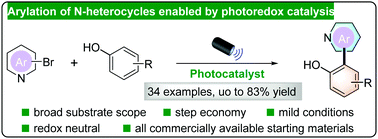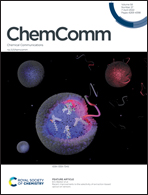Direct arylation of N-heterocycles enabled by photoredox catalysis†
Abstract
N-Heterobiaryls are common skeletons found in biological molecules, pharmaceuticals and ligands. Herein, we document an efficient and redox-neutral photocatalytic system to obtain functionalized N-heterobiaryls under mild conditions. Substrates bearing variegated functional groups are compatible with the developed photocatalytic conditions. This method is translatable to gram-scale synthesis, with a photocatalyst loading as low as 0.1 mol% and minimal variation of the yield. The starting materials are commercially available, demonstrating the practicality and accessibility of this methodology. Interestingly, phenols can serve both as coupling partners and proton donors. Arenes without a phenolic hydroxyl group also underwent efficient coupling with HFIP as a solvent.

- This article is part of the themed collection: Sustainable synthesis and catalysis – Chemical Science symposium collection


 Please wait while we load your content...
Please wait while we load your content...